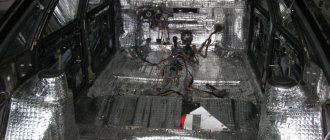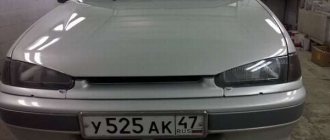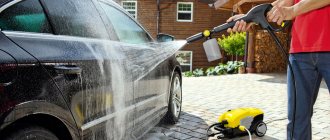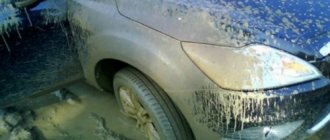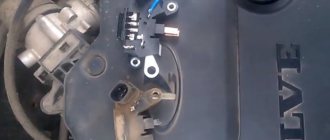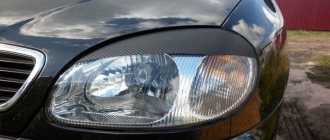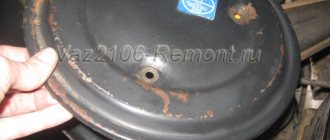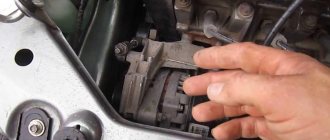To be honest, among my friends, opinions on under-hood soundproofing differ significantly. Some say that they really got the effect, others insist that it is a waste of time and money. But there is one thing in common between them, both of them agree that with comprehensive sound insulation of the entire car, it will not be superfluous to treat the hood.
Personally, I can say the following: if you completely lack standard hood sound insulation, then you need to carry it out, but if you have it, you can skip this step, you shouldn’t expect a super effect, besides, if you do something wrong, it may get even worse.
What effect will I get if I do this work?
Firstly, if you comprehensively treat not only the hood, but also the engine department, then you will definitely get rid of some of the sound from the engine in the cabin.
Secondly, the effect of thermal insulation will be added and in the cold season the engine will cool down less, which is also good news.
How complicated is the process itself?
To be honest, quieting the hood is probably the easiest solution to implement, and you can easily handle all the procedures yourself. Plus, the low cost of materials and ease of installation will really surprise you.
Do you want to get the maximum effect from the work done? Make additional sound insulation of the car roof.
Tired of road noise? Can you hear every hole? Soundproofing the wheel arches will help - https://avtoshum.com/obesshumka-kolesnye-arki.
Step by step implementation
At the first stage, you will need to install a vibration-isolating layer of material. In this case, it is applied locally. Among the requirements for the material, one can highlight temperature stability, since during the warm season the engine compartment is kept at a high temperature, and this layer can simply “float”.
An excellent solution would be to use the following materials: Vizomat MP or Bimast Super.
The primary processing scheme is shown in the figure below.
At the second stage, sound and heat insulation is carried out. In fact, as a material you can use a high-quality building thermal insulator, which has a foil layer.
This material will reflect sound waves, but there is no point in installing noise absorbers.
Here is a diagram of the second stage of hood soundproofing.
Example of hood treatment
Materials and tools you need:
- Vibroplast M1 - 2 sheets;
- Alcohol or other degreaser;
- ISOTON LM - 1 sheet;
- hard roller;
- Rags.
Rules for car soundproofing
- The following rules apply to soundproofing any area of the car. Compliance with these recommendations will ensure 100% success of the noise insulation work carried out, the result of which will reach an almost professional level.
- The vibration-absorbing material, which is applied as the first layer, should be glued to a previously cleaned surface of dust, dirt and rust. Follow the principle of cleaning the surface “for painting”.
- After cleaning, the surface should be treated with a degreaser. It is better to use White Spirit for this.
- Before covering the surface to be treated with soundproofing material, it should be rolled into place. This is done like this: a sheet of material is taken, applied to the surface to be treated and rolled with a special roller.
- It is better to process figured body elements using patterns made of hard cardboard. To do this, you should make patterns that will exactly follow the desired contours.
- Before removing the protective film from the adhesive surface, you should attach the pattern to the desired location to ensure that the contour part of the body is accurately repeated. Making patterns will take you a little time, but will save on material and make the work process easier.
What are the advantages
Sound insulation work can make the interior of the car more comfortable. They take a lot of time and require significant material costs. Usually, vibration-isolating materials are glued first, which dampen the vibration of metal parts. After this, materials are used that absorb noise. Such materials have a foam structure, which allows not only to remove noise, but also to perform a heat-insulating function.
As a rule, disassembling the machine is necessary for complete sound insulation. The doors, hood, trunk lid, and other parts are removed. The fender liners are removed from the wheel arches. The electrical wiring is disconnected, the seats are removed from the interior, the carpets and interior upholstery are removed. A thorough inspection of body parts from the inside is carried out. If signs of corrosion are detected, they are removed. These areas are coated with an anti-corrosion compound, primed and painted over.
Then the surfaces are prepared for laying soundproofing materials. To do this, they are thoroughly cleaned and degreased. To prepare the parts and noise-insulating material, templates are first cut out of paper or cardboard and carefully adjusted to the surface, taking into account the subsequent installation of the dismantled parts. It is better to take the material itself as self-adhesive, which makes the work more convenient and of better quality. The glued soundproofing parts are carefully smoothed and dried with a stream of warm air.
As a result of high-quality sound insulation, the car owner receives:
- Silence in the car interior, absence of sounds of unknown origin.
- High-quality sound and rich audio system sound.
- Ability to talk calmly while driving.
- Objective information about the condition of body parts.
- Faster warming up of the engine and car interior and slower cooling.
- Clearer and smoother door closing.
- Improved handling by lowering the center of gravity.
Vibration isolation of the hood: first layer
To eliminate metal vibrations, vibration absorbers should be used as the material for the first layer. Considering the fact that the engine compartment maintains a high temperature, the choice of material should be based on its ability to withstand thermal effects. Therefore, it is advisable to choose those materials that require heating during pasting; more elastic vibration absorbers can “float”. The presence of an aluminum surface of the material is also desirable; the fact is that the foil layer reflects heat waves well. Bimast Super or Vizomat MP are ideal for these purposes. Most cars have a hood, which is a rigid frame consisting of a steel profile, parts of which are soldered together, and a sheet of steel, which is, in fact, the hood cover. The vibration absorber should only be applied to the hood cover from the inside, cutting out small pieces using patterns that repeat the flat areas between the stiffeners.
It is important not to get carried away with excessive layering of material, since if you, for example, paste over the stiffeners, the hood lid may skid over time.
Car soundproofing mat UR Convenience
The UR Convenience brand has launched a new automotive insulator for the hood and interior. The noise insulating mat is made of powder-free aluminum material.
Car soundproofing mat UR Convenience
The metal sheet is mounted on a cotton backing. The car mat provides reliable sound insulation of the engine compartment and reduces vibration vibrations by 80%.
| Manufacturer/series | UR Convenience |
| Sound insulator type | Sheet, metal sheet on cotton backing |
| Dimensions: width\length\thickness (in cm) | 50x20000x2 |
| Sheet weight | From 30 gr. |
| Application | Hood, roof, doors, mudguards |
| Installation features | Self-adhesive. Not used as a heat or sound insulator. |
| Sales party | 1 PC. |
| Link to the product | https://alli.pub/5t73rl |
Factory sound insulation: third layer
If it was available, then we install it in place, if not, then we should stop there. Some aesthetes treat the soundproofed surface with madeleine, so it takes on a more well-groomed appearance.
Whether you choose to soundproof the hood is up to you. We advise you to produce it in combination with the “Shumka” of the engine shield. This way you will definitely drown out all the sounds that accompany the operation of the engine and transmission. The high-quality “noise” of the hood and engine shield at idle engine speeds can completely silence the engine from the interior, and at speeds above 3000 make its operation much quieter.
The sound of a running engine and metal vibration are some of the main sources of noise in the car interior. The “noise” of the hood is usually performed in conjunction with sound insulation of other elements (floor, doors, arches) and significantly improves the acoustic comfort in the car. In this article we will tell you how to make hood soundproofing with your own hands.
Soundproof Car City Sticker
If you need to ensure airtight closure of the interior doors, trunk, and hood, it is better to select a universal type of black sealing tape. The Car City brand model is designed for installation in place of the standard seal on any brand of passenger car.
Soundproof Car City Sticker
Made from heat-resistant rubber polymer. The high elasticity of the material, resistance to aggressive reagents and resistance to temperature changes provide high sound insulation of the interior.
| Manufacturer/series | Car City |
| Sound insulator type | Sealant |
| Dimensions: width\length\thickness (in cm) | Molded, for installation in standard places - 1.2, 3 meters |
| Application | Hood, roof, doors, mudguards, wheel arches |
| Installation features | Self-adhesive. Used as a heat and sound insulator. |
| Sales party | From 1 meter |
| Link to the product | https://alli.pub/5t73ha |
How to choose vibration and noise insulation for the hood?
Study the opinions of customers who have worked with this material and pay attention to the following parameters:
- how it is glued to curved surfaces;
- plastic;
- smell (high-quality modern materials do not have a strong unpleasant odor);
- complexity of installation in general.
Among the long-established and reputable manufacturers on the market, we can note the brands STP and Shumoff. It is better to purchase the material in reserve.
SRIMXS Rubber Z Seal
The SRIMXS brand offers a series of door seals that reduce the penetration of external noise by 70%. The rubber seal is made of a high-strength rubber component with the addition of a heat-resistant polymer. The elastic seal has a Z-shape and is self-adhesive.
SRIMXS Rubber Z Seal
An adhesive coating is applied to one part of the board and protected by a backing. The driver just needs to measure the required length, cut and install the door seal. The range includes flat, Z-shaped seals, one-piece circular sound insulators with a self-adhesive side. The models are suitable for any class of car, any model year.
| Manufacturer/series | SRIMXS |
| Sound insulator type | Bay |
| Dimensions: width\length\thickness (in cm) | Depending on the shape |
| Weight | 20 g/meter |
| Application | Soundproof door seal |
| Installation features | Self-adhesive |
| Link to the product | https://alli.pub/5t731q |
Stages of hood soundproofing
- Carefully remove the hood trim. It is advisable to remove the clips with a special remover to avoid damage.
- Clean the surface. It is necessary to thoroughly clean the metal from dirt, dust, and rust.
- Degrease the surface. You can use the solvent Gasoline Galosh, White Spirit.
- We make patterns from thick paper. Vibration and noise insulation is glued to the areas between the stiffeners. These areas have a complex shape. Take the time to prepare the patterns. The more accurate your patterns are, the more accurate the whole work will be. There is no need to seal the stiffeners, since in this case cavities will form in which condensation will accumulate.
- We try on the patterns in place.
- We draw the contours of the patterns on the vibration and noise insulation. Cut it out.
- We apply vibration and noise insulation, smooth it with our hands and carefully roll it with a special roller, starting from the middle. The material should fit tightly to the metal.
- Reinstall the hood trim. If the clips for fastening the casing are damaged during removal, replace them with new ones.
Self Adhesive Rubber Sealing Strip QCBXYYXH
The universal seal reduces the penetration of sound into the interior by 30%, ensures a tight connection between glass and metal, and prevents paint chips from chipping. The sealing tape from the QCBXYYXH brand is made of high-strength rubber polymer and is highly resistant to mechanical damage. Operating temperatures – from -40 to +150.
Self Adhesive Rubber Sealing Strip QCBXYYXH
The seal has a self-adhesive side, protected by a backing, is installed in standard places, and is suitable for all models of passenger cars.
| Manufacturer/series | QCBXYYXH |
| Sound insulator type | Sealant |
| Dimensions: width\length\thickness (in cm) | Z-shaped tape, 3 m long |
| Weight | From 300 gr. |
| Application | Glazing of doors, windshield, trunk doors |
| Installation features | Self-adhesive. |
| Sales party | 3m |
| Link to the product | https://alli.pub/5t73uw |
Result
Vibro-noise-insulating material will serve not only as protection against noise, but also as additional thermal insulation of the hood. The engine will cool down slower and warm up faster.
In this article we looked at how to make hood soundproofing with your own hands. However, the work can also be done in a specialized technical center. You don’t have to figure out the features of sound insulation yourself. All work will be done by qualified specialists. You will save time and not lose much money, because soundproofing the hood is inexpensive.
You can find out all the details about our services by calling the numbers listed in the Contacts section.
Where to begin
First of all, many people ask questions about the advisability of the soundproofing procedure specifically on the engine side in the engine compartment.
There is an opinion that this is a completely useless event. And supposedly there is no meaning in it. But this is said mainly by those who have not felt the difference between cars with and without sound insulation, or who initially drive a car that has high-quality and efficient noise insulation from the factory. In the second case, I really don’t see the point in further insulating the engine compartment. But this occurs mainly on expensive and new cars. Owners of older and cheaper cars are less fortunate.
Cars that have been in use for more than one year, produced more than 10 years ago, usually have high noise and vibration from the engine. And even when running at idle.
And you shouldn’t blame only diesel engines. Gasoline engines also vibrate a lot and require additional noise.
The noise emanating from the engine irritates the driver, interferes with concentration, prevents him from fully enjoying music, and distracts him from driving. Noise is also a danger to the hearing organs.
It is equally important to get rid of vibrations. Soundproofing won't help here
But a special heat-resistant engine cushion will be an ideal solution to this situation. The pillow has the necessary combination of rigidity and elasticity, which gives it the ability to dampen vibrations. A mount is mounted under the engine. These elements take the brunt of the impact and the load. For added comfort, you can consider installing air bags in the springs, which also brings great benefits.
Purchasing materials for the engine compartment noise is not a problem. It is much more important to use their properties and capabilities correctly.
Insulation of other areas - trunk, wheel arches and arches
The trunk repeatedly amplifies the sounds reflected in it and turns them into a general hum. Unsecured loads also create additional noise. The insulation of the luggage compartment follows a similar scheme with other parts of the car: dismantling all items, cleaning, degreasing, installing a vibration absorber and sound insulator.
Materials are used to cover the entire area joint to joint. The sequence is as follows: rear wheel arches, horizontal surface of the trunk floor, rear wing niches. The final stage is soundproofing the trunk lid like a car door.
The wheel arches also require special attention. They create noise in the cabin from the contact of the wheels with the road surface, and in winter - from the studs on winter tires. There are different options: you can stick the material from the engine side, luggage compartment or interior, as well as from the outside - from the wheel side. In each case, you can use materials from the Liplent line. Do not forget about pre-cleaning and drying the metal.
You can do all this work yourself. Be patient, act slowly and carefully. Liplent tapes do not require special installation skills. The main thing is to properly prepare the surface and press the sound and vibration insulator tightly. Step by step - from the hood to the trunk - you will improve the acoustic background in the cabin and will no longer be distracted by unpleasant sounds while driving your favorite car.
